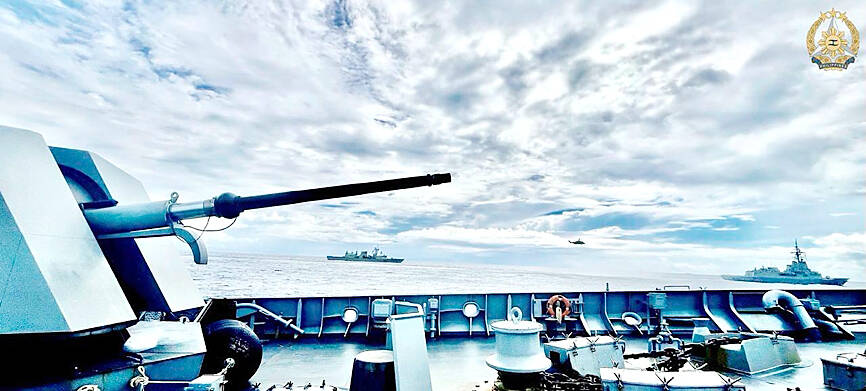Advanced brain scans found perplexing differences in US diplomats who say they have developed concussion-like symptoms after working in Cuba, a finding that only heightens the mystery of what might have happened to them, a new study said.
Extensive imaging tests showed that the workers had less white matter than a comparison group of healthy people and other structural differences, researchers said.
While they had expected the cerebellum, near the brain stem, to be affected given the workers’ reported symptoms — balance problems, sleep and thinking difficulties, headaches and other complaints — they said that they found unique patterns in tissue connecting brain regions.
Ragini Verma, a University of Pennsylvania brain imaging specialist and the lead author of the study, said that the patterns were unlike anything she has seen from brain diseases or injuries.
“It is pretty strange. It’s a true medical mystery,” Verma said.
Coauthor Randel Swanson, a Penn specialist in brain injury rehabilitation, said that “there’s no question that something happened,” but imaging tests cannot determine what it was.
An outside expert, University of Edinburgh neurologist Jon Stone, said the study does not confirm that any brain injury occurred, nor that the brain differences resulted from the strange experiences the diplomats claimed happened in Cuba.
Cuba has denied any kind of attack, the allegations of which have strained relations with the US.
The results were published on Tuesday in JAMA: The Journal of the American Medical Association.
A journal editorial said that the study might improve understanding of the reported symptoms, but that the relevance of the brain differences is uncertain.
In a statement, the US Department of State said that it “is aware of the study and welcomes the medical community’s discussion on this incredibly complex issue. The department’s top priority remains the safety, security and well-being of its staff.”
Between late 2016 and May last year, several US and Canadian diplomats in Havana complained of health problems from an unknown cause.
One US government count put the number of affected US personnel at 26.
Some reported hearing high-pitched sounds similar to crickets while at home or staying in hotels, leading to an early theory of a sonic attack.
The Associated Press has reported that an interim FBI report found no evidence that sound waves could have caused the damage.
Dozens of US diplomats, family members and other workers sought exams.
The new study said that 40 of them were tested at the University of Pennsylvania.
A group analysis of results from advanced magnetic resonance imaging scans found brain differences in the diplomat group compared with 48 healthy people with similar ages and ethnic background.
Workers had the tests about six months after reporting problems, but because their brains were not scanned before their Cuba stints, they cannot know for certain if anything changed in their brains, a drawback of the study that the researchers acknowledged.
The new study has several other limitations that weaken the results, including a comparison group that was not evenly matched to the patients, Stone said.
“If you really want to suggest that something fundamentally different happened in Cuba ... then the best control group would be 40 individuals with the same symptoms who hadn’t been to Cuba and had no history of head injury,” Stone said.
The latest study builds on earlier preliminary reports involving 21 US workers who got brain scans showing less-detailed white matter changes. The new study includes 20 of those workers.
A previous study by the University of Miami found inner-ear damage in some workers who complained of strange noises and sensations, but it also lacked any presymptom medical records.
Although some workers have persistent symptoms, most have improved with physical and occupational therapy, are doing well and have returned to work, Swanson said.
As more time passes, “it’s going to be harder and harder to figure out what really happened,” he said.

Australia has announced an agreement with the tiny Pacific nation Nauru enabling it to send hundreds of immigrants to the barren island. The deal affects more than 220 immigrants in Australia, including some convicted of serious crimes. Australian Minister of Home Affairs Tony Burke signed the memorandum of understanding on a visit to Nauru, the government said in a statement on Friday. “It contains undertakings for the proper treatment and long-term residence of people who have no legal right to stay in Australia, to be received in Nauru,” it said. “Australia will provide funding to underpin this arrangement and support Nauru’s long-term economic

‘NEO-NAZIS’: A minister described the rally as ‘spreading hate’ and ‘dividing our communities,’ adding that it had been organized and promoted by far-right groups Thousands of Australians joined anti-immigration rallies across the country yesterday that the center-left government condemned, saying they sought to spread hate and were linked to neo-Nazis. “March for Australia” rallies against immigration were held in Sydney, and other state capitals and regional centers, according to the group’s Web site. “Mass migration has torn at the bonds that held our communities together,” the Web site said. The group posted on X on Saturday that the rallies aimed to do “what the mainstream politicians never have the courage to do: demand an end to mass immigration.” The group also said it was concerned about culture,

ANGER: Unrest worsened after a taxi driver was killed by a police vehicle on Thursday, as protesters set alight government buildings across the nation Protests worsened overnight across major cities of Indonesia, far beyond the capital, Jakarta, as demonstrators defied Indonesian President Prabowo Subianto’s call for calm. The most serious unrest was seen in the eastern city of Makassar, while protests also unfolded in Bandung, Surabaya, Solo and Yogyakarta. By yesterday morning, crowds had dispersed in Jakarta. Troops patrolled the streets with tactical vehicles and helped civilians clear trash, although smoke was still rising in various protest sites. Three people died and five were injured in Makassar when protesters set fire to the regional parliament building during a plenary session on Friday evening, according to

STILL AFLOAT: Satellite images show that a Chinese ship damaged in a collision earlier this month was under repair on Hainan, but Beijing has not commented on the incident Australia, Canada and the Philippines on Wednesday deployed three warships and aircraft for drills against simulated aerial threats off a disputed South China Sea shoal where Chinese forces have used risky maneuvers to try to drive away Manila’s aircraft and ships. The Philippine military said the naval drills east of Scarborough Shoal (Huangyan Island, 黃岩島) were concluded safely, and it did not mention any encounter with China’s coast guard, navy or suspected militia ships, which have been closely guarding the uninhabited fishing atoll off northwestern Philippines for years. Chinese officials did not immediately issue any comment on the naval drills, but they